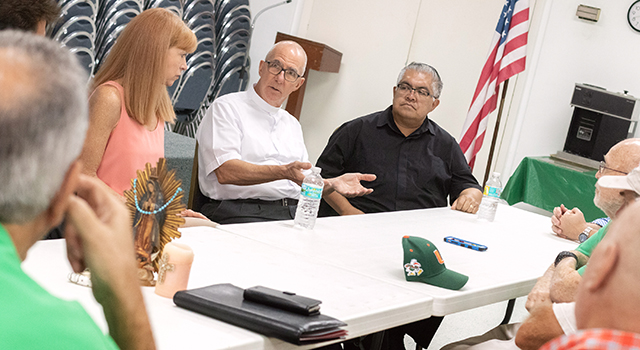By Tom Tracy - Florida Catholic
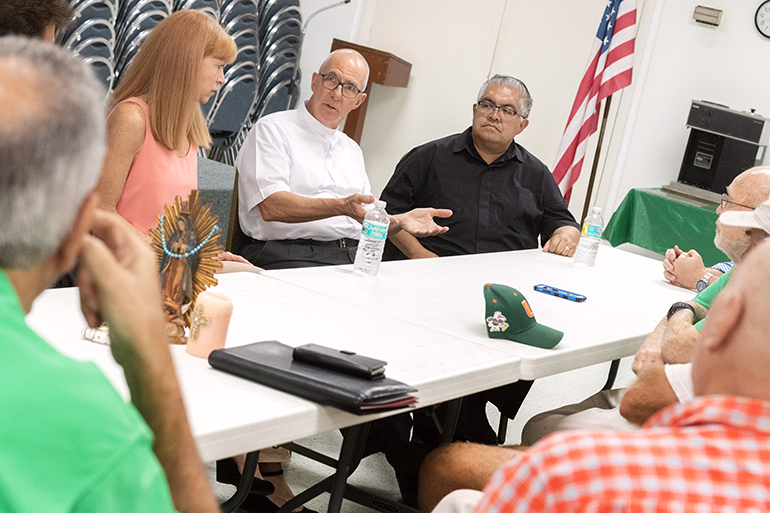
Photographer: TOM TRACY | FC
Father Luis Alberto Perez, pastor of San Pablo Catholic Church, center, speaks with members of a delegation of the board of directors for Catholic Charities of the Archdiocese of Miami during a recent tour of parishes and programs in Monroe County. At right is Msgr. Roberto Garza, who chairs Catholic Charities' board of directors.
This is the second in a series about Monroe County parishes and the work of Catholic Charities in the Florida Keys.
MARATHON, Florida | It’s one thing to recover from a catastrophe, but quite another when the surrounding community is still in recovery mode — and in one of the most transient, expensive places to live in America.
That’s the challenge for San Pablo Parish in the Middle Keys, which is moving forward with rebuilding several parish structures, as well as a new sense of community, following 2017’s Hurricane Irma, one of the Atlantic’s strongest hurricanes on record. Irma reached peak winds of 185 mph and a Category 4 strength when it landed here.
As of late 2019, the church’s property insurance has freed up funds for replacing the church office, rectory and an annex structure along with a fortified sea wall that was damaged beyond repair.
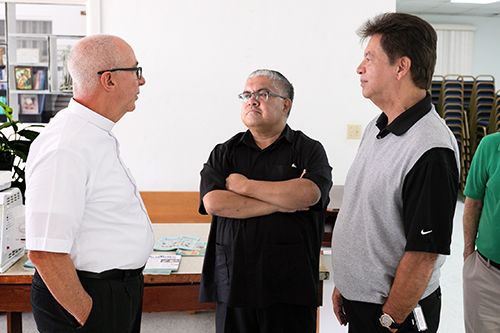
Photographer: TOM TRACY | FC
Father Luis Alberto Perez, pastor of San Pablo Parish in Marathon in the Florida Keys, left, talks with Msgr. Roberto Garza, who chairs the board of directors of Catholic Charities for the Archdiocese of Miami. On the right is Peter Routsis-Arroyo, director of Catholic Charities of the Archdiocese of Miami. They met recently during a Catholic Charities Board of Directors tour of Monroe County.
“The new rectory and office structure will now be located on the main parish campus and will be built to meet the current hurricane and FEMA flood elevation codes,” said David Prada, senior director of the archdiocese’s Building and Properties Office. Completion of the building projects is expected sometime next summer.
The new rectory and office buildings will be set back further from the surrounding water than before Irma touched down, according to Father Luis Alberto Perez, pastor of San Pablo Parish for more than a year.
“Many parishioners left and didn’t return and also — because of insurance situations – many of the homes are still being demolished,” the priest told a delegation of Catholic Charities of Miami board of directors who visited in October.
The priest noted that many workers to the Marathon area bus down daily from the mainland towns of Florida City and Homestead due to the local housing scarcity.
Residents of Monroe County need to make $3,835 every month to maintain a modest standard of living, making it the most expensive place to live in Florida, according to a new analysis from “24/7 Wall St.,” which examined the county in each state that is the most expensive to live in.
Father Perez estimated there about 150 families at San Pablo and some three quarters of parishioners are seasonal; many of those stay for a short-term vacation of only a week or two a year in total.
COOPERATION
Cooperation with other community agencies is the best way to get things done in Monroe County. San Pablo Parish is a partner with KAIR — Keys Area Interdenominational Resources — in Marathon, which offers assistance to local people in need of help, according to Father Perez.
It was after Hurricane Irma that the faith groups and governmental agencies really got together and decided that would be the best means of centralizing care for Marathon.
“There are a lot of homeless people that I have seen in Marathon and so KAIR is located in the ‘downtown’ in Marathon. And the hospitals here do not offer the expertise that South Miami would, so when something happens here you go to Miami,” the priest said.
With hurricanes come changes and new parishioners stepping in and willing to take up where others have left off. Marathon is seeing some of that dynamic, according to Father Perez: “We are very happy to have a family that just moved in with seven children and so we have three new children as altar servers now. We are baptizing more now and meeting the families where they are at: The Spanish (language) Mass is growing, and the children bring the parents to church, so we have (religious education classes) on Sunday between Masses.”
The priest said the women’s club is a very important part of the parish life, along with religious education programming for over 30 children. The RCIA has been restarted this year with 13 adults seeking to become full members of the Catholic Church.
ABOVE SEA LEVEL
The new parish buildings will be built about four feet from sea level and a foot higher in total than the parish church, according to Paul Navarra, director of operations at San Pablo, who for the past 19 years has managed and maintained the Prayer Garden and church grounds.
The new sea wall requirements are six inches higher than the existing sea wall — an increase that has more to do with environmental regulations concerning runoff draining into the canals than with preventing storm surge, according to Navarra. He noted that city and county numbers showed that some nine percent of the population left after Hurricane Irma.
“The population numbers are slowly coming back and the school population has taken a pickup this year, but we are still down for Mass attendance and collection mode. Real estate prices here constantly go up as it’s becoming more and more vacation oriented,” Navarra said.
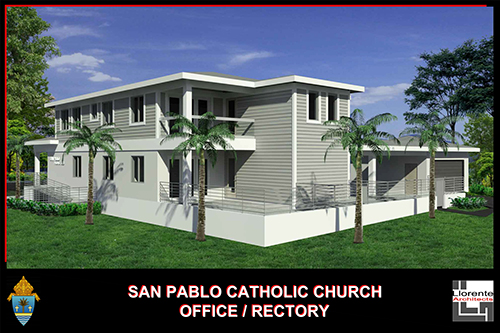
Photographer: TOM TRACY | FC
Architect's rendering of the new San Pablo Church office and rectory, which are being rebuilt to the latest code after being battered by Hurricane Irma in 2017.
Tom Commerford, a Catholic Charities board member and a Miami resident who was on hand during the October fact-finding tour of the Keys, pointed out that many of the people working here are getting their social services assistance from the Homestead area rather than locally.
Marianne Finizio, a San Pablo parishioner, sees a strengthening local community in Marathon following the hurricane. She is vice president of community relations and business development at Community Health of South Florida who recently moved full time to a home in nearby LongKey, north of Marathon. She helps out with a new health clinic in Marathon where clients pay on a sliding scale.
“We are seeing a lot of businesses now getting a foothold after the hurricane but the rents are very high and it's just not affordable if you don’t have a good job,” Finizio said, adding that the region’s only emergency shelter for the homeless is located in Stock Island near Key West.
YOUNGER FAMILIES
There is an upside to the turnover and exodus following Hurricane Irma: “We are seeing younger families and younger adults coming in,” Finizio said.
Patrice Schwermer, the Key West-based Catholic Charities program director for Monroe County, noted the amount of creativity and cooperation in filling in the gaps in social services in Monroe County through a long-term recovery group following Hurricane Irma.
“If you remember, with Hurricane Irma it was mostly the Middle Keys all the way to Big Pine that were very affected. Some of the homes are still being rebuilt and Charities has been a very active part of the long-term recovery group,” she said, adding that Catholic Charities played a lead role in the post-Irma response, including providing transportation assistance to families wishing to evacuate immediately following the storm.
“People with less resources or lost incomes just could not get reestablished and find a place to live and economically rebound — those are many of the people we saw and with some help were able to get relocated,” Schwermer said. “Income disparity is an issue here in the Keys and is one of the highest in the country.”
Catholic Charities Board Member and CPA Craig Armstrong, a member of St. Louis Parish in Pinecrest, said he thinks the Florida Keys are in a transitional state with a generational change in property ownership and a generational selling of vacation properties passed down from parents to children.
“It’s not just a Florida Keys issue, it's a South Florida issue and I feel there has to be an educational effort with the community as a whole to say it is not just about finding affordable housing for the workforce but to integrating the workforce into the community as a whole and elevating the community as a whole,” Armstrong said. “Everything works better that way and the two can’t be mutually exclusive.”
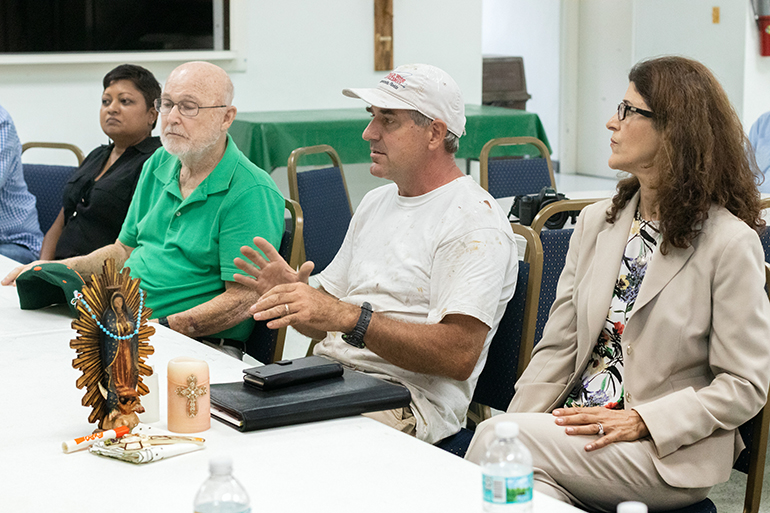
Photographer: TOM TRACY | FC
Paul Navarro, center, director of operations at San Pablo Catholic Church, speaks to members of a delegation of the board of directors for Catholic Charities of the Archdiocese of Miami during a recent tour of parishes and programs in Monroe County.
